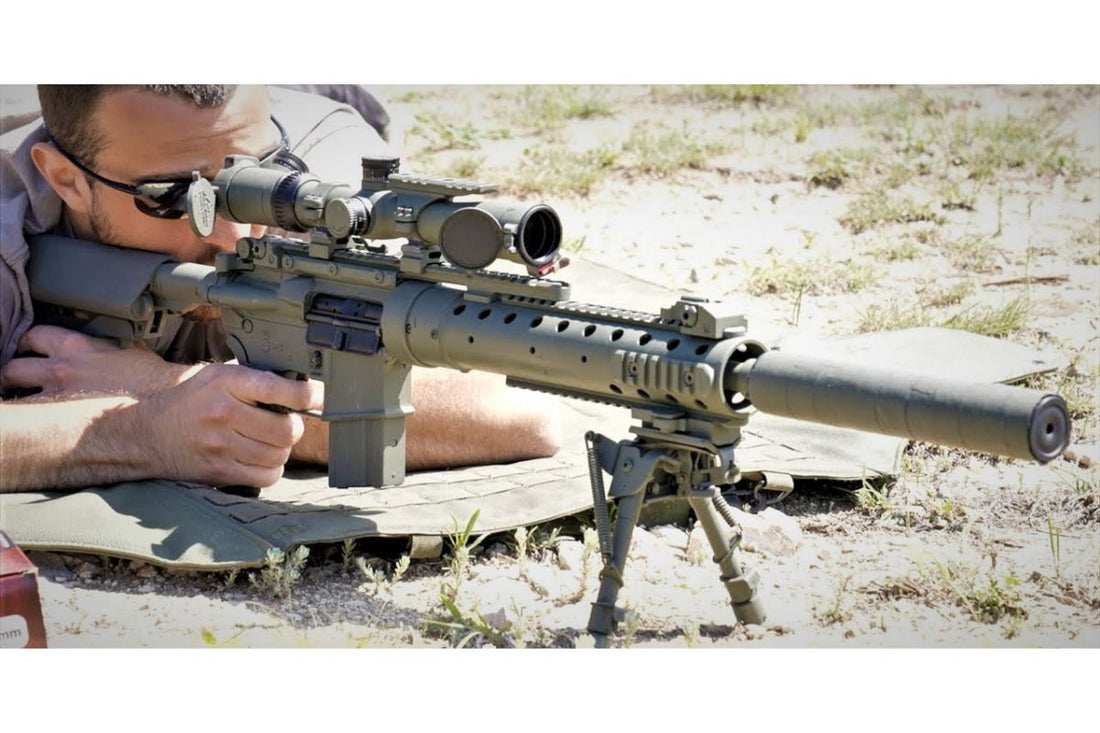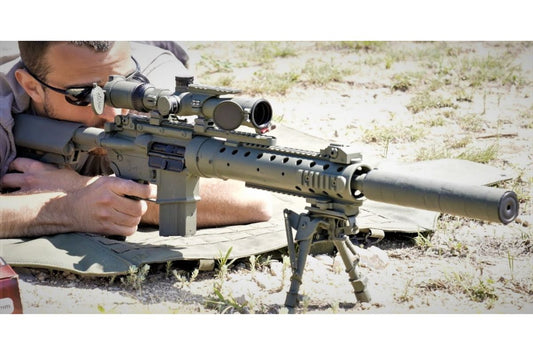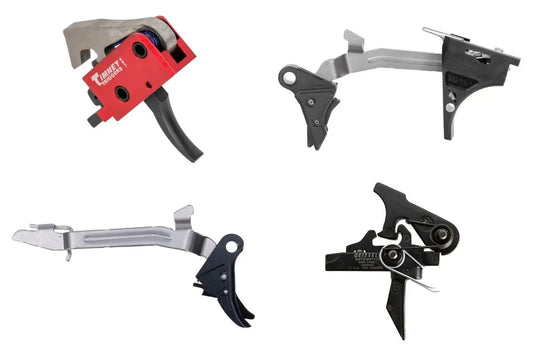
Mk12 SPR Decoded: A No-BS Guide to Mod 0 vs. Mod 1 vs. Mod H
TL;DR for Skimmers
- Mod 0 = 18" Douglas barrel, PRI carbon-fiber tube + ARMS sleeve, heavier, OG “SPR look.”
- Mod 1 = 18" Douglas barrel, KAC M4 Match FF RAS quad-rail, lighter, broader SOF issue (SEALs/Rangers), accessory-friendly.
- Mod H (“Holland”) = 16" compact retrofit with PRI Gen III tube, intermediate/mid-length gas, ACE SOCOM stock; built for tighter spaces with minimal accuracy penalty.
- All three were optimized around Black Hills Mk262 77-gr ammo for reach and terminal effect.
Quick Comparison Table
|
Variant |
Barrel & Gas |
Handguard / Top Rail |
Typical Sights/Optics |
Weight (approx.) |
Who used it most |
Signature Parts You Can Still Buy |
|
Mk12 Mod 0 |
18" Douglas SS, rifle-length gas |
PRI Gen I/III carbon-fiber FF tube + ARMS #38 SPR sleeve |
Leupold Mark 4 MR/T 2.5-8×36 (TS-30A1/A2); ARMS #40 rear; PRI flip front |
~11.7 lb |
Army SF; early GWOT |
PRI 18" Douglas barrel; PRI Mod 0 uppers; Allen Engineering AEM5 suppressor. |
|
Mk12 Mod 1 |
18" Douglas SS, rifle-length gas |
Knight’s M4 Match Free-Floating RAS (KAC P/N 99167/21318) |
Same Leupold 2.5-8×; KAC 600m rear + KAC flip front |
~10.8 lb |
SEALs, Rangers, AFSOC |
KAC FF RAS (Mod 1 rail); Centurion Arms Mod 1 complete; Leupold MR/T TS-30 A2. |
|
Mk12 Mod H (“Holland”) |
16" match SS (Douglas/Noveske seen), intermediate/mid-length gas |
PRI Gen III rifle-length tube (often FDE), rail-mounted front sight |
Same optic family; often ACE SOCOM stock |
n/a (varied by build) |
Favored in Army SOF for urban/CQB-adjacent roles |
PRI Mod H 16.5" uppers; Noveske Mod H 16" barrels. |
“The major difference in the Mod 0 and Mod 1 is the handguard assembly and the back-up sights.” — Christopher R. Bartocci, Small Arms Defense Journal (SADJ).
The Big Picture: What “SPR” Actually Meant
Originally, SPR was a “Special Purpose Receiver”—a precision upper meant to bolt onto an M4 lower under the SOPMOD program. As the concept matured, it was type-classified as a complete Mk12 Special Purpose Rifle by NSWC Crane for SOF use. The DNA remained the same: a free-floated, heavy-contour 18" stainless barrel optimized around Black Hills Mk262 77-gr ammo to stretch the 5.56 to 600+ yards with minimal weight and maximum portability compared to 7.62 guns.
Variant Deep-Dive
Mk12 Mod 0: The Classic “PRI + ARMS Sleeve” SPR
Hardware recipe.
- Barrel: 18" Douglas 416R stainless, 1:7 twist, rifle-length gas; profiled for the Ops Inc/Allen Engineering collar/brake system. PRI still sells the correct Douglas 18" tubes.
- Handguard/rail: PRI carbon-fiber Gen III free-float tube plus ARMS #38 SPR top-rail “sleeve” bridging to the receiver.
- BUIS: ARMS #40 rear, PRI flip front on the gas block.
- Optic: Commonly Leupold Mark 4 MR/T 2.5-8×36 TS-30A1/A2 (yes, the one with the 36mm objective and Mk262-calibrated M2 turrets in some runs).
- Suppressor: The system was built around the Ops Inc 12th Model, now Allen Engineering AEM5—identical interface (mount + collar) and repeatability that DMRs prize. Product pages spell this out.
Performance & feel.
Mod 0 is a touch heavier (SADJ lists ~11.7 lb complete), but that mass helps when you’re shooting from support or with a can. The ARMS sleeve gives you optic real estate and maintains alignment across upper + fore end, but it’s a more closed ecosystem than a full quad-rail. If you want to build or buy close to “issue,” PRI sells complete Mod 0 rifles/uppers and the Douglas barrels.
Direct-to-product starting points:
- PRI / Douglas 18" Mk12 barrel (SPR profile, 5.56 NATO, rifle-gas).
- PRI Mk12 Mod 0 complete rifle/upper (clone-correct layouts).
- Allen Engineering AEM5 suppressor (Ops Inc 12th Model lineage).
Pros
- Ultimate “SPR look” & historically correct.
- Excellent barrel quality; built around Mk262 accuracy.
- ARMS sleeve gives long optic base, very rigid setup.
Cons
- Heavier; the sleeve and tube limit accessory flexibility vs. Mod 1.
- Sourcing ARMS/PRI bits can be a scavenger hunt at times.
- With today’s accessories, quad-rails or modern M-LOK are simpler.
Mk12 Mod 1: The KAC Quad-Rail Era
What changed?
Crane moved to a Knight’s Armament M4 Match Free-Floating RAS (KAC P/N 99167/21318), ditching the ARMS sleeve and embracing a full quad-rail. It shaved weight, simplified accessory mounting, and—practically—made logistics easier across teams already deep in KAC rail ecosystems. SADJ pegs a completed Mod 1 at ~10.8 lb and specifies the KAC sights used.
Hardware recipe.
- Barrel: Same 18" Douglas 416R SS, 1:7, rifle-gas, Ops Inc/AEM5 muzzle interface.
- Handguard: KAC M4 Match FF RAS (rifle-length), the Mod-1 hallmark. These still pop up from KAC reseller channels and limited runs.
- Sights: KAC flip-up 600 m rear (98474) and KAC flip front (99051).
- Optic: The same Leupold Mark 4 MR/T 2.5-8×36 (TS-30A2). Leupold itself catalogs this association.
- Complete rifles: Centurion Arms continues to offer Mod 1 complete rifles built to spec with Douglas tubes.
Direct-to-product starting points:
- KAC FF RAS, rifle-length (Mod 1 rail)—multiple sources carry P/N 21318/99167.
- Centurion Arms Mk12 Mod 1 complete (correct rail/barrel recipe).
- Leupold Mark 4 MR/T 2.5-8×36 TS-30 A2 (Mk12-correct optic).
Pros
- Lighter and more accessory-friendly than Mod 0.
- KAC rail integrates seamlessly with common mounts/lights.
- Broadest operational footprint (NSW/SEALs, Rangers, USAF ST).
Cons
- Authentic KAC rails are pricey and scarce (collector tax).
- You lose the ARMS sleeve optic span (not an issue for most).
- Some purists prefer the Mod 0’s carbon-fiber tube for weight/heat.
Mk12 Mod H (“Holland”): The 16-Inch Urban DMR
Why the H exists.
By mid-GWOT, units wanted Mk12 performance in a handier package. In July 2007, PRI performed an official retrofit on twelve rifles at Fort Campbell: 16" Douglas barrel (1:8), intermediate gas, PRI Gen III forearm, rail-mounted front sight, ACE SOCOM stock, updated brake/collar—the kit we now shorthand as “Mod H.” SADJ documents the parts list. – Small Arms Defense Journal (SADJ)
Common real-world builds.
- Barrels: 16" Douglas or Noveske match, with correct Ops Inc/AEM5 contour and mid/intermediate gas. Noveske’s Mod H 16" (stainless) is a known pattern; PRI sells a Mod H upper today.
- Handguard: PRI Gen III rifle-length tube (often FDE).
- Stock: ACE SOCOM (per the 2007 PRI rebuild).
Direct-to-product starting points:
- PRI Mk12 Mod H 16.5" upper (complete, gas buster, sights, AE brake/collar).
- Noveske Mk12 Mod H 16" barrel (Holland-pattern).
What you gain/lose.
- Gain: Faster handling, shorter OAL (especially with a can), more forgiving gas in adverse conditions (intermediate/mid-length).
- Give-up: A small velocity loss vs. 18"; with Mk262, real-world drop/wind differences are minor out to the typical SPR envelope.
Pros
- The handiest of the Mk12 family—16" + AEM5 makes sense in/around vehicles and urban cover.
- Balances beautifully with a suppressor.
- Officially documented retrofit—so it’s not just a clone-culture concoction. – Small Arms Defense Journal (SADJ)
Cons
- Not as instantly “recognizable” as Mod 0 or Mod 1.
- Slightly less muzzle velocity vs. 18".
- Purist parts validation takes homework (more variation).
Ammo: Mk262 Is the Secret Sauce
The Mk12 was optimized with Black Hills to run the Mk262 77-gr OTM. SADJ details the Mod 0 → Mod 1 evolution of the load to fix cold-weather cycling, propellant heat sensitivity, and ultimately deliver a lethal, highly accurate 5.56 package tailored to the 18" gas system—with knock-on benefits for M4/Mk18.
Expert voice. Jeff Hoffman (Black Hills) has repeatedly emphasized the accuracy standards they hold Mk262 to; civilian Mk262 Mod 1-C mirrors the military spec closely. A recent interview puts numbers to their QC mindset: “We hew to high accuracy standards, in both commercial and military ammunition.” And independent reporting notes 300-yard 10×10 test groups and lot cards signed by Hoffman.
Direct-to-product:
- Black Hills Mk262 Mod 1C (civilian) is widely sold; specs and product pages spell out the same AEM5-friendly muzzle system assumptions.
Optics: The Leupold TS-30 Line Was “The” Mk12 Scope
The Leupold Mark 4 MR/T 2.5-8×36 (TS-30A1/A2) is the historically correct optic for Mod 0/Mod 1; Leupold’s own heritage page ties that glass to the Mk12 program and OEF deployment. Clone-correct M2 turrets were even calibrated for Mk262. If you’re going “issue,” start here; if you’re going “performance,” modern LPVOs exist, but they’re not what made an SPR an SPR.
Direct-to-product:
- Leupold Mark 4 MR/T 2.5-8×36 TS-30 A2 (Mk12-correct).
Handguards & Rails: PRI vs. KAC vs. PRI (again)
- PRI Gen III (Mod 0/H): Carbon-fiber/aluminum, ARMS sleeve on Mod 0; light, stiff, but accessory-limited. PRI still sells Mod 0/H uppers and parts.
- KAC M4 Match FF RAS (Mod 1): Rifle-length free-float quad with KAC sights. Authentic rails (P/N 99167/21318) trade like vintage watches; a few dealers run limited batches.
Suppressors: The System Was Built Around Ops Inc / AEM5
The Ops Inc 12th Model evolved into the Allen Engineering AEM5—same collar-and-mount interface, the repeatability and POI stability that made Mk12s sing. If you want “real,” the AEM5 is the answer; note you’ll need the correct brake + collar and a barrel properly contoured for it. Product pages lay out attachment geometry and added length/past-muzzle figures.
Which One Should You Build (or Buy) in 2025?
Choose Mod 0 if you want:
- The iconic SPR silhouette (PRI tube + ARMS sleeve).
- Maximum historical fidelity to early GWOT guns.
- You mostly shoot supported, appreciate a touch more weight, and like the longer optic rail.
Where to start: PRI 18" Douglas barrel, PRI Mod 0 uppers, AEM5.
Choose Mod 1 if you want:
- The lightest 18" Mk12 with true quad-rail flexibility.
- The version most often associated with NSW/SEALs and Rangers.
- Easier mounting for PEQs, bipods, white light, and clip-on night gear.
Where to start: KAC FF RAS 21318/99167, Centurion Arms complete Mod 1, Leupold 2.5-8×.
Choose Mod H if you want:
- A more compact Mk12 that stays true to the program’s spirit.
- Better balance with a suppressor and easier vehicular/urban handling.
- A historically documented PRI retrofit rather than a modern reinterpretation.
Where to start: PRI Mod H 16.5" upper, Noveske 16" Mod H barrel, AEM5.
Real-World Nuance (and Clone-Builder Notes)
- Barrels & chambers. Douglas was the selected barrel maker; Compass Lake Engineering machined many of the SPR-profile tubes and offers Wylde/CLE chambers today. For clone integrity, look for the Ops Inc/AEM5 muzzle contour and rifle-length gas on 18", or intermediate/mid-length on 16".
- Weights vary with optics, cans, bipods, and lights. SADJ’s 11.7 lb (Mod 0) vs. 10.8 lb (Mod 1) are solid reference points for “complete fighting rifles.”
- Parts scarcity & prices. Genuine KAC Mod 1 rails can command collector-level pricing; patience (and alerts) pay off.
- Ammunition availability. Civilian Mk262 Mod 1-C is widely available and mirrors the military ballistics/accuracy envelope; Hoffman’s interviews and third-party testing back this up.
- Optic alternatives. If you’re building a shooter (not a museum piece), a modern 1-8× LPVO with a daylight-bright center dot will outpace the Leupold in speed at 1×, but you’ll lose clone correctness. (Opinionated take: if it’s a Mod H with a can, a rugged LPVO makes a ton of sense.)
- Gas system pragmatics. The 18" rifle-gas SPR was tuned around Mk262, a suppressor, and a specific firing schedule. If you’re running unsuppressed, dirty, and cold, the Mod H intermediate gas recipe can be less finicky. SADJ’s development notes and cold-weather fixes are instructive.
What the Experts Say
- On Mod 0 vs. Mod 1 differences: “The major difference… is the handguard assembly and the back-up sights.” — C.R. Bartocci, SADJ. – Small Arms Defense Journal (SADJ)
- On Mod H’s official pedigree: PRI’s July 2007 Fort Campbell rebuild list shows 16" barrel, intermediate gas, PRI Gen III forearm, ACE SOCOM stock—i.e., “Mod H.” (Documented parts list in SADJ.) – Small Arms Defense Journal (SADJ)
- On Mk262 accuracy culture: “We hew to high accuracy standards, in both commercial and military ammunition.” — Jeff Hoffman, Black Hills. Third-party reporting documents 10×10 at 300-yard acceptance for lot cards.
Product Links (Carefully Curated, top-shelf only)
- PRI Mk12 Mod 0 rifle/uppers (current production).
- PRI 18" Douglas Mk12 barrel (SPR profile, rifle-gas, AEM5 contour).
- Centurion Arms Mk12 Mod 1 complete rifle (Douglas barrel + KAC rail).
- KAC M4 Match FF RAS (Mod 1 rail)—multiple reputable sources.
- Allen Engineering AEM5 (Ops Inc 12th)—factory page + select dealers.
- Noveske Mk12 Mod H 16" barrel (Holland-pattern).
- PRI Mk12 Mod H 16.5" upper (turn-key).
- Leupold Mark 4 MR/T 2.5-8×36 (TS-30 A2)—Mk12-correct optic.
- Compass Lake Engineering SPR barrels (Douglas/Criterion, correct contours and gas options).
Buying Advice by Use-Case
- Practical DMR for 2025: If you’ll run a can, shoot positional, and value agility, a Mod H with AEM5, LPVO, and a crisp two-stage trigger is the sweet spot. You keep Mk12 DNA without the extra inches of the 18".
- Collector-grade clone: Mod 1 is the smartest play: lighter, clean-lined, and more flexible than Mod 0, with deep documented SOF use. Factor in the KAC rail hunt cost up front.
- Range nostalgia / “the look”: Mod 0. The PRI tube and ARMS sleeve are unmistakable. Pair with the Leupold 2.5-8× and an AEM5 and smile every time that “SPR crack” turns into a soft thump under the can.
Pros & Cons, Summed Up
Mod 0
- Pros: Iconic; superb accuracy; long optic rail; true to early program.
- Cons: Heavier; accessory limitations; parts chase.
Mod 1
- Pros: Lighter; user-friendly quad-rail; most fielded; easy to mount modern accessories.
- Cons: Authentic KAC rails are scarce/expensive; slightly less “romance” than Mod 0.
Mod H
- Pros: Best handling with suppressor; compact without gutting performance; documented Crane/PRI retrofit.
- Cons: Less standardized; not as “famous” visually; small velocity trade-off from 18".
Final Take
Functionally, the barrel length/gas and handguard architecture are what separate these variants. If you’re buying or building to shoot, the Mod H is the most livable. If you’re buying or building to own a piece of history, the Mod 1 is the smartest clone with fewer compromises in day-to-day use than Mod 0. If you want the purest SPR vibe, nothing beats a Mod 0 with the Leupold 2.5-8× and an AEM5.
Either way, feed it Mk262—that’s what the system was built around, and it’s the invisible edge that makes the Mk12 punch way above 5.56’s weight class. – Small Arms Defense Journal (SADJ)
Shop for Mk12 (Mod 0/1/H) at Guns.com.




